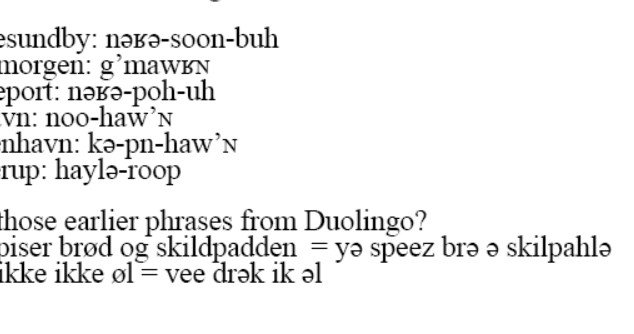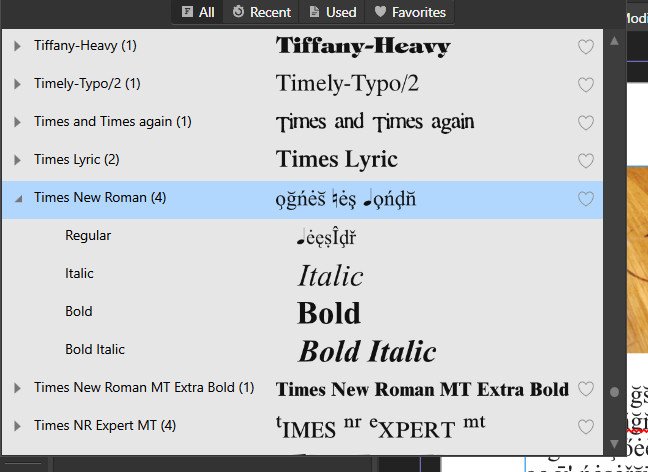
Kalvos
Members-
Posts
9 -
Joined
-
Last visited
-
 Kalvos reacted to a post in a topic:
Vertical black line in Publisher text frame tool
Kalvos reacted to a post in a topic:
Vertical black line in Publisher text frame tool
-
Kalvos started following Vertical black line in Publisher text frame tool
-
 Dan C reacted to a post in a topic:
Times New Roman problem
Dan C reacted to a post in a topic:
Times New Roman problem
-
Hi Dan, This was solved above. Since Affinity substituted the Most Serif font, I went looking for it. I didn't want to delete it because I use it regularly. It turns out that it was identifying itself in its PostScript name as TimesNewRomanPSMT. I'm guessing that Affinity goes in alphabetical order when loading fonts? In any case, I opened it in a font editor and changed the PostScript name to MostSerif, and then all was well. Other programs seem to behave differently in loading fonts, perhaps ignoring the PostScript name? I don't know. For now, this is fixed. If it comes up again, I'll try clearing via the AppData. Thanks very much!
-
 Kalvos reacted to a post in a topic:
Times New Roman problem
Kalvos reacted to a post in a topic:
Times New Roman problem
-
 lacerto reacted to a post in a topic:
Times New Roman problem
lacerto reacted to a post in a topic:
Times New Roman problem
-
 kenmcd reacted to a post in a topic:
Times New Roman problem
kenmcd reacted to a post in a topic:
Times New Roman problem
-
That was it. Most was what Affinity was substituting. I opened it in High-Logic Font Creator (which I use for developing fonts) and sure enough, its Postscript name was Times New Roman PSMT. I changes it PS name to "MostSerif" (its filename) and the correct TNR popped up in Affinity. Thanks to everone
-
Since I've shifted back to InDesign and have a deadline, I'll post those as soon as I can. To be clear, it's not the extended characters per se that are the problem; they're part of Times New Roman v7.00, which is installed on this Windows 10 machine. The characters were not available in Times New Roman PSMT, so they didn't show up in Publisher, which only allowed TNR/PSMT for regular text. Once I'd uninstalled TNR/PSMT, Publisher subsituted a different font. As you can see in my OP, it doesn't see TNR at all now. The entire document has a random font replacing TNR Regular (but not TNR bold, italic, or bold italic). This is the case for any new document--there's no TNR Regular available to Publisher. As mentioned in the previous post to Dan C, I've done the whole Windows cache reset/rebuild and cleared all the Publisher options and reboot.
-
Thanks for the suggestion, and I did so. No change. I then did it again, re-setting everything on the panel. No change. The closest other font with roughly the same metrics as Times New Roman and that has the extended character set is Tahoma -- but it has no italics. So for now, I've started the project over in InDesign, which sees all the variants of Times New Roman and displays the extended characters..
-
Thank you for the suggestion. I had already deleted the old font file, which caused the original problem of not having special characters in the extended area (schwa, inverted R, etc.). I followed the instructions for deleting the cache, restarting, etc. The cache folder was empty and I rebooted. Affinity still does not find Times New Roman regular -- only bold, italic, and bold italic. Those fonts do have the extended characters, by the way. What's especially difficult for me at this point is that the phonetic material was near the end of the document and I didn't discover the font failure until I reached that area in layout. Now that the PSMT file is gone, I can't recover the document layout at all (no other font has close enough metrics to TNR). Does Affinity itself have a font cache? I found the fonts.xml file, but it only has recent font names. And as I said, this is not a problem with any other application (Word, OpenOffice, Finale, Foxit PDF, Paint Shop Pro, Vegas Video, etc.). The project is due Friday so I still have time to figure this out without redoing the entire layout with a new font. Thanks again, Dennis
-
Hi all, Windows 10 font issue only witn Affinity Publisher. I brought in a large text file that uses Times New Roman extended characters. Affinity Publisher changes the font to Times New Roman PSMT. It will not change to Times New Roman regular, and so the extended characters are not showing up. There is no option for another font in the font manager. I uninstalled Times New Roman PSMT, restarted the computer, and Affinity Publisher now shows Times New Roman regular as some entirely different font (in this case, a music font called Most). It displays bold, italic, and bold italic, but NOT regular. I need the extended characters and so need the 'real' Times New Roman to do that, not PSMT, which is an incomplete font. Images showing the text in the document (bold showing correctly) and the drop-down font list. (Times New Roman regular shows up correctly in MS Word, OpenOffice, etc., and in the Windows font list.) Can anyone help with this? Thank you!




